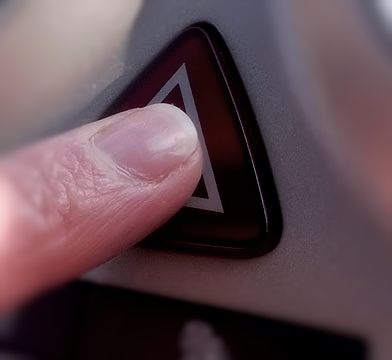Before we cover the topic of ‘when we should use hazard warning lights’, let’s take a quick look at:
What are hazard warning lights
Hazard warning lights are when all four of a cars indicators flash continuously and simultaneously whilst activated. Car hazard warning lights are frequently used inappropriately by many motorists.
Knowing when to use hazard lights appropriately is important as drivers will typically slow down when they see hazard lights illuminated. Inappropriate or unnecessary use of hazard lights can in itself become a potential hazard. This section explains what are hazard warning lights, when they should and should not be used.
Hazard warning lights whilst driving
Highway Code rules states that you MUST NOT use hazard warning lights while driving or being towed unless you are on a motorway or unrestricted dual carriageway and you need to warn drivers behind you of a hazard or obstruction ahead.

When it is recommended to use hazard warning lights whilst driving
Whilst driving on motorways and dual carriageways at high speed, reaching hazards or obstructions ahead happens quickly. Activating hazard warning lights provides drivers behind that a hazardous situation is ahead.
When it is not recommended to use hazard warning lights whilst driving
If you are moving slowly in particular, it may seem courteous and perhaps even common sense to activate your hazard warning lights. Problems arise however when you intend on changing direction, junctions and lanes as an inability to signal due to hazard lights being activated will become highly dangerous as motorists will have no way of knowing which direction you intend on taking.
Another situation when it may seem appropriate to use hazard warning lights is if you are moving much slower that other traffic because you are looking for a building, are lost or are unsure where you are going. Again this renders your indicators ineffective and causes confusion to other motorists. If you find yourself in this situation and are becoming stressed, do not use your hazard warning lights and instead pull over if possible or find a legal place to stop to wait for traffic to subside.
Hazard warning lights whilst stationary
Hazard warning lights may be used when a vehicle is stationary and is causing a temporary obstruction to other traffic. In regards to the law, the use of hazard warning lights used as an excuse for parking illegally or dangerously will not lessen the offence.
When it is not recommended to use hazard warning lights whilst stationary
The decision to activate hazard warning lights whilst stationary must be decided depending on each situation. A vehicle may for example be parked with the hazard warning lights activated.
The left (nearside) indicators could be obscured by other parked vehicles or objects giving the impression that the vehicle intends to pull out, ultimately causing more of a potential hazard than if the hazards were not activated. It’s important to ensure that the use of hazard lights help other road users and not further confuse matters.
When to use hazard warning lights
Hazard warning lights should be used only when:
- your vehicle has broken down in a hazardous or dangerous location that may affect other traffic
- your vehicle has broken down on the motorway and has stopped on the hard shoulder
- you are traveling on a motorway or unrestricted dual carriageway and you intend on warning following drivers of a hazard or obstruction ahead
Hazard light fines and penalties
Although there isn’t a penalty directly associated with the inappropriate use of hazard lights, penalties and fines may apply due to the circumstances involving the reasons for using your hazard lights inappropriately.

If there’s is a car pile up on a bridge, should i switch on my hazard lights?
Hello Arno,
Yes, it’s generally a good idea to warn other drivers of an impending hazard.
If you are in a situation where your car malfunctions on a rural road, nota motorway or a dual carriageway which results in you needing to drive significantly slower, Is it a good idea to use hazard lights?
Hi Matt,
On a rural road, personally I would if the speed is significantly slower than normal.
when did this all change? It used to written in the highway traffic act that it was law and later highly recommended to us hazard lights while traveling more than 20 km below the speed limit or driving slowly in inclement weather. I have read it myself! Now I can'[t find it.
Hi Jeff,
I think the overuse of hazard warning lights can create a hazard itself. I’m sure you must have been driving and seen a driver’s right indicator flashing whilst parked, only to realise when passing it’s their hazard warning lights on.